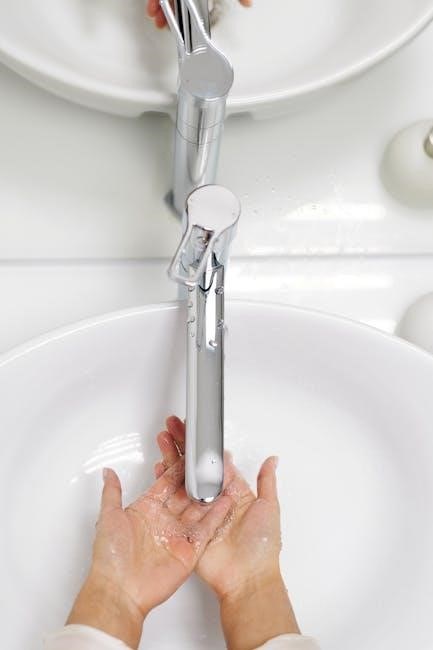Tap drill size charts are essential tools for precise drilling and tapping operations, providing standard thread specifications for various applications. They include British Standard, National Pipe Threads, and ISO Metric sizes, ensuring accurate hole preparation. These charts are widely available as free PDF downloads, offering convenient access for machinists and manufacturers.

What is a Tap Drill Size Chart?
A tap drill size chart is a reference guide that specifies the correct drill bit size for creating threaded holes in materials. It provides precise measurements for various thread types, including British Standard, National Pipe Threads, and ISO Metric sizes. The chart typically lists the tap size, major diameter, pitch, and corresponding drill size in both inch and metric units. This tool is indispensable for machinists, engineers, and manufacturers to ensure accurate and consistent results. By using a tap drill chart, professionals can avoid common errors like oversized or undersized holes, which can lead to thread damage or poor fitment. Many charts are available as free PDF downloads, making them easily accessible for quick reference during machining operations.
Importance of Tap Drill Size Charts in Machining
Tap drill size charts are crucial in machining for ensuring precision and consistency in threaded hole production. They provide exact drill bit sizes, preventing errors that could lead to thread damage or poor fitment. By using these charts, machinists can maintain tight tolerances, which are essential for the proper functioning of mechanical components. Additionally, they save time by eliminating the need for trial-and-error drilling, reducing material waste and increasing productivity. The availability of free PDF downloads makes these charts easily accessible, allowing professionals to quickly reference the correct drill sizes for various thread types, including British Standard, National Pipe Threads, and ISO Metric. This ensures high-quality outcomes and adherence to industry standards in manufacturing processes.
Understanding Tap Drill Sizes
Tap drill sizes are critical for creating precise threads, involving major diameter, minor diameter, and pitch measurements. These specifications ensure proper thread formation and accuracy in machining processes.

Basic Definitions: Major Diameter, Minor Diameter, and Pitch
The major diameter is the largest diameter of a screw thread, while the minor diameter is the smallest. Pitch refers to the distance between threads. These measurements are fundamental for selecting the correct tap drill size, ensuring proper thread fit and alignment. The major diameter determines the tap size, while the minor diameter influences the tap’s fit within the material. Pitch, measured in threads per inch (TPI) or millimeters, dictates the spacing of the threads. Understanding these definitions is crucial for accurate drilling and tapping operations. They are universally applied across British Standard, National Pipe, and ISO Metric threads, ensuring consistency in machining processes. Proper alignment and fit are achieved by adhering to these specifications, minimizing errors in thread creation.
How to Read a Tap Drill Size Chart
A tap drill size chart is a structured guide that helps machinists determine the correct drill size for threading operations. It typically includes columns for screw size, major diameter, pitch, and the corresponding drill size. The chart is organized by screw size, with each row providing the necessary measurements for accurate drilling. To use it, match the screw size to its major diameter and pitch, then find the recommended drill size. Drill sizes are often listed as decimal or fractional values, depending on the chart’s format. Understanding how to interpret these values ensures proper thread fit and alignment. The chart also distinguishes between tap and clearance drills, which is critical for avoiding common errors. By following the chart, users can achieve precise and professional results in their machining projects.

Types of Threads and Their Charts
British Standard, National Pipe, and ISO Metric threads each have specific tap drill charts, ensuring compatibility and precision. These charts are widely available as free PDF downloads.
British Standard Pipe Threads (BSW, BSPP, BSPT)
British Standard Pipe Threads, including BSW, BSPP, and BSPT, are widely used in piping systems. BSW (British Standard Whitworth) threads are for general engineering, while BSPP (British Standard Pipe Parallel) and BSPT (British Standard Pipe Taper) are specific to pipe connections. These threads have defined pitch and diameter specifications, ensuring compatibility and leak-free joints. Tap drill size charts for these threads are readily available as free PDF downloads, providing machinists with precise drill sizes for various pipe diameters and pitches. For example, a 1/8″ BSPP thread requires a 0.098″ drill size, while a 1/4″ BSPT uses a 7/16″ drill. These charts are essential for accurate drilling and tapping in industrial and plumbing applications, ensuring proper thread engagement and system integrity.
National Pipe Threads (NPT, NPTF, NPS, NPSF)
National Pipe Threads (NPT, NPTF, NPS, NPSF) are standard in North America for pipe connections. NPT threads are tapered, ensuring a tight seal, while NPTF (National Pipe Tapered Fuel) are for fuel and high-pressure applications. NPS (National Pipe Straight) and NPSF (National Pipe Straight Fuel) are straight threads. Tap drill size charts for these threads are available as free PDF downloads, providing precise drill sizes. For instance, a 1/8″ NPT thread requires a 0.332″ drill, while a 1/4″ NPS uses a 7/16″ drill. These charts are crucial for machinists to ensure accurate drilling and tapping, preventing leaks and ensuring thread integrity in industrial and plumbing systems. Proper drill selection is vital for maintaining the structural and functional reliability of pipework.
ISO Metric Threads
ISO Metric Threads are widely used internationally, offering standardized thread specifications for compatibility and precision. Tap drill size charts for ISO Metric Threads provide essential data for drilling and tapping. For example, an M1.6 thread requires a 1.25mm drill, while an M2 thread uses a 1.60mm drill. These charts are available as free PDF downloads, ensuring easy access for machinists. They include details like major diameter, pitch, and drill sizes, making them indispensable for manufacturing and engineering projects. ISO Metric Thread charts are particularly useful for ensuring accuracy in global projects, where uniformity and interchangeability of parts are critical. By referencing these charts, professionals can achieve precise thread tolerances, ensuring durability and functionality in assembled components.
Common Tap Drill Size Charts
Common tap drill size charts include inch and metric equivalents, providing universal compatibility. They list decimal equivalents for drill sizes, ensuring precise hole preparation for tapping operations. These charts are widely available as free PDF downloads, offering convenient access for machinists and manufacturers.

Inch and Metric Tap Drill Size Equivalents

Inch and metric tap drill size equivalents are crucial for ensuring compatibility between different measurement systems. These charts provide precise drill sizes for both inch-based and metric thread specifications, allowing seamless conversion. For example, a 1/16-27 NPT tap requires a drill size of 0.242 inches, while an M1.6 metric tap uses a 1.25 mm drill. The charts list decimal equivalents, making it easier to match drill bits to tap sizes. This dual-system approach ensures accuracy and avoids errors in machining. Free PDF downloads of these charts are widely available, offering a quick reference for machinists and manufacturers. By using these equivalents, professionals can maintain consistency and precision across global projects, regardless of the measurement system in use.
Decimal Equivalents for Drill Sizes
Decimal equivalents for drill sizes are vital for precise machining operations, providing exact measurements for drill bits. These values are often included in tap drill charts, ensuring accurate hole preparation. For instance, a #80 drill bit has a decimal equivalent of 0.0135 inches, while a #56 drill is 0.0465 inches. These measurements are critical for achieving the correct tap fit, whether for clearance or tapping. Free PDF charts offer comprehensive lists of decimal equivalents, making it easy to reference during manufacturing. By using these precise values, machinists can avoid errors and ensure threads are cut accurately. This attention to detail is essential for maintaining quality and consistency in both small-scale and industrial production environments.


How to Use a Tap Drill Size Chart
Using a tap drill chart involves matching screw sizes to drill sizes for precise tapping. Start by identifying the thread type and size, then locate the corresponding drill size in the chart. Ensure the drill bit size aligns with the tap size for a proper fit. Always refer to the chart’s decimal equivalents for accuracy. Downloading a free PDF chart simplifies the process, providing a quick reference guide for machinists. Proper use ensures accurate drilling and tapping, reducing errors and improving efficiency in manufacturing and machining projects.
Step-by-Step Guide to Selecting the Right Drill Size
To select the right drill size, start by identifying the screw or tap size and thread type (e.g., NPT, ISO metric). Refer to the tap drill chart to find the corresponding drill size for your specific thread. Match the screw size to the chart’s drill size column, ensuring alignment with the thread pitch and type. Check the decimal equivalents for precise measurements. Always verify the chart’s units (inch or metric) to avoid errors. For free PDF charts, download and print them for easy reference. Proper drill size selection ensures a snug fit for tapping, minimizing errors and improving efficiency in machining and manufacturing processes. Accurate drilling is critical for thread quality and durability.
Matching Screw Sizes to Drill Sizes

Matching screw sizes to drill sizes is crucial for ensuring proper thread fit and durability. Start by identifying the screw size and thread type (e.g., NPT, ISO metric) from the tap drill chart. Locate the corresponding drill size for the screw size, considering the thread pitch and type. Use decimal equivalents for precise measurements, as fractional sizes may vary. For example, a 1/4-18 screw requires a specific drill size to ensure the tap fits correctly. Always cross-reference the chart to avoid mismatches. Free PDF charts provide detailed tables for quick lookup, ensuring accuracy. Proper alignment between screw and drill sizes prevents thread damage and ensures a secure fit, which is essential for both machining and manufacturing applications. This step is critical for achieving professional-grade results in tapping operations.
Free PDF Resources for Tap Drill Size Charts
Free PDF resources for tap drill size charts are widely available online, offering detailed tables for ISO Metric, British Standard, and National Pipe Threads. Download from trusted websites.
Where to Download Free Tap Drill Size Charts
Several websites offer free PDF downloads of tap drill size charts, including technical forums, engineering resource platforms, and manufacturer sites. Popular options include ISO Metric, British Standard, and National Pipe Threads charts. These resources provide detailed tables for various thread types, ensuring accurate hole preparation. Users can search for “tap drill size chart PDF free download” to find reliable sources. Many sites also offer charts in multiple formats, such as Word documents or text files, for easy customization. Always verify the credibility of the source to ensure accuracy and compliance with industry standards.
Recommended Websites for Reliable Charts
For reliable tap drill size charts, visit reputable engineering and manufacturing websites. Sites like Engineering ToolBox and Technical Handbook offer free, downloadable PDF charts. These platforms provide detailed tables for ISO Metric, British Standard, and National Pipe Threads. Additionally, manufacturer websites such as McMaster-Carr and Grainger often include free resources. Online forums like Practical Machinist also share community-verified charts. Ensure the source is credible to maintain accuracy. Many sites allow customization, enabling users to tailor charts to specific needs. Always check for updates to stay current with industry standards. These resources are invaluable for professionals and hobbyists alike, ensuring precise drilling and tapping operations.

Applications of Tap Drill Size Charts
Tap drill size charts are crucial in machining, manufacturing, and engineering for precise hole preparation. They ensure accurate thread creation, essential for aerospace and automotive industries, where durability and safety are critical.
Use in Machining and Manufacturing
In machining and manufacturing, tap drill size charts are indispensable for ensuring precise hole preparation and thread creation. They provide exact measurements for drill sizes, pitches, and thread types, enabling manufacturers to maintain consistency and quality. By referencing these charts, machinists can avoid common errors such as oversized or undersized holes, which can lead to thread damage or assembly issues. The availability of free PDF downloads makes these charts easily accessible, allowing manufacturers to streamline their processes and adhere to industry standards. This ensures that final products meet specifications, enhancing reliability and performance across various applications.
Importance in Aerospace and Automotive Industries
In the aerospace and automotive industries, precision is critical, making tap drill size charts vital for ensuring the integrity of threaded components. These charts provide the exact drill sizes and thread specifications required for high-performance materials and applications. In aerospace, where safety and durability are paramount, accurate tapping ensures that components can withstand extreme conditions. Similarly, in automotive manufacturing, precise thread creation is essential for engine parts, bolts, and other critical components. Free PDF downloads of these charts are widely used by engineers and technicians to maintain consistency and meet stringent industry standards, thereby reducing the risk of failure and ensuring reliability in final products.
Tips for Using Tap Drill Size Charts Effectively
Always verify drill sizes with the chart, use the correct tap for thread type, and ensure drill bits are sharp for precise results. Refer to the chart’s legend for clarity and double-check measurements before drilling to avoid errors.
Common Mistakes to Avoid
One of the most frequent errors is selecting the wrong drill size, leading to incorrect thread fit. Using outdated charts or misinterpreting measurements can result in oversized or undersized holes. Another mistake is neglecting to account for thread type differences, such as between NPT and ISO metric threads. Additionally, failing to ensure drill bit sharpness can cause uneven tapping. It’s crucial to cross-reference sizes and thread specifications to avoid these pitfalls. Always use a reliable tap drill size chart PDF for accurate measurements and double-check calculations before drilling. Proper preparation and attention to detail are key to achieving professional results in machining and manufacturing.
Best Practices for Accurate Drilling and Tapping
For precise drilling and tapping, always use a high-quality tap drill size chart PDF to ensure accurate measurements. Start by selecting the correct drill bit size based on the thread type and material. Maintain sharp tools to prevent wear and tear. Use a rigid setup to minimize vibration and ensure straight drilling. Apply the recommended cutting oil or coolant to reduce friction and improve finish. After drilling, inspect the hole for diameter accuracy before tapping. Use a tap wrench or tapping guide for controlled threading. Finally, verify the tapped hole with a go/no-go gauge to ensure thread quality. Adhering to these practices guarantees professional-grade results in machining and manufacturing processes.
Conclusion
Tap drill size charts are indispensable for precise machining, offering free PDF downloads for easy access. They ensure accuracy, efficiency, and consistency in drilling and tapping processes across industries.
Summary of Key Points
Tap drill size charts are crucial for ensuring precision in machining and manufacturing. They provide standardized measurements for various thread types, including NPT, ISO, and BSP. Free PDF downloads offer easy access to these charts, enabling accurate drill size selection. The charts list tap sizes, drill sizes, and decimal equivalents, simplifying the process of matching screws to drills. They are essential for maintaining consistency and quality in threaded fasteners. By using these charts, professionals can avoid common mistakes and achieve optimal results in drilling and tapping operations. Their availability in multiple formats ensures versatility for different user needs, making them indispensable tools in both amateur and professional settings.
Final Thoughts on the Importance of Tap Drill Size Charts
Tap drill size charts are indispensable tools for ensuring precision and accuracy in machining and manufacturing. They provide critical data for selecting the correct drill sizes, preventing errors, and optimizing thread quality. Their availability in free PDF formats makes them accessible to professionals and hobbyists alike, promoting consistency across industries. By adhering to these charts, users can avoid common pitfalls like oversized or undersized holes, which lead to material waste and project delays. Their importance extends to maintaining quality standards in aerospace, automotive, and other precision engineering fields. Ultimately, tap drill size charts are essential for achieving professional-grade results in any threading application, making them a cornerstone of modern machining practices.